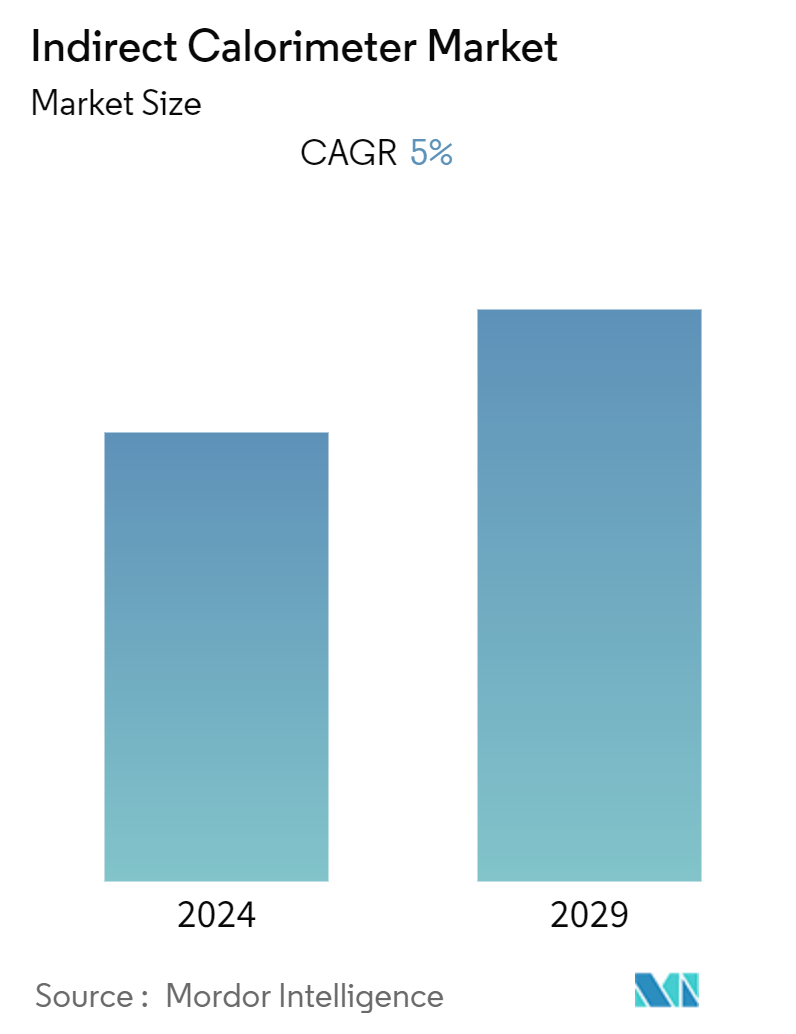Market Size of Indirect Calorimeter Industry

| Study Period | 2019 - 2029 |
| Base Year For Estimation | 2023 |
| Forecast Data Period | 2024 - 2029 |
| CAGR (2024 - 2029) | 5.00 % |
| Fastest Growing Market | Asia Pacific |
| Largest Market | North America |
Major Players
*Disclaimer: Major Players sorted in no particular order |
Indirect Calorimeter Market Analysis
The Indirect Calorimeter Market is expected to register a CAGR of 5% during the forecast period.
The market is witnessing growth propelled by technological advancements in indirect calorimeters and escalating global obesity rates. Over the past few decades, obesity has surged on a global scale. For instance, as per the World Obesity Atlas 2023, across African countries, 1 in 13 men (7.76%) and 1 in 5 women (20.41%) are projected to have a body mass index of more than 30 kg by 2030. This equates to approximately 27 million men and 74 million women in the region at risk of complications of obesity by 2030. Thus, the growing burden of obesity is expected to increase demand for indirect colorimeters to measure energy, thereby boosting market growth.
Obesity is strongly associated with several serious diseases, notably cardiovascular conditions such as heart disease and stroke, diabetes, musculoskeletal issues like osteoarthritis, and a range of cancers, including endometrial, breast, ovarian, prostate, liver, gallbladder, kidney, and colon. These conditions significantly impact the quality of life and can lead to increased mortality rates. The most popular technique for measuring energy expenditure in research settings is indirect calorimetry, which has produced previously unheard-of insights into the systems that regulate energy balance in response to weight loss or growth.
Indirect calorimeters, among other medical devices, are increasingly vital in healthcare. A key challenge for companies lies in staying abreast of regulatory mandates and seamlessly integrating them into their production processes. Furthermore, the technological advancements in indirect calorimeters are expected to drive market growth. For instance, as per an article published in August 2022 in PubMed, longitudinal indirect calorimeter (IC) measurements taken before, during, and after ICU care may be needed to become the new global standard of care for directing nutritional care given recent advancements in IC technologies and the widespread availability of a new generation of IC equipment.
Hence, due to the increase in obesity cases and the rise in technological advancements in indirect calorimeters, the market studied is expected to witness growth over the forecast period. However, the high cost of the devices and stringent regulatory guidelines are likely to restrain market growth over the forecast period.
Indirect Calorimeter Industry Segmentation
As per the scope of the report, indirect calorimeters refer to devices that use the reference standard and clinically recommended means to measure energy expenditure. Indirect calorimetry is nothing but a type of whole-body calorimetry where all gas consumption and gas exhalation are continuously monitored. It can be used to determine energy expenditure through the use of equations relating to total O2 consumption, CO2 expiration, and urinary nitrogen excretion to energy utilization.
The indirect calorimeter market is segmented by type, end user, and geography. By type, the market is segmented into standalone and portable. By end user, the market is segmented into hospitals, diagnostic centers, and other end users. By geography, the market is segmented into North America, Europe, Asia-Pacific, and the Rest of the World.
The report offers the market sizes and forecasts in value terms (USD) for the above segments.
| By Type | |
| Standalone | |
| Portable |
| By End User | |
| Hospitals | |
| Diagnostic Centers | |
| Other End Users |
| Geography | |||||||
| |||||||
| |||||||
| |||||||
| Rest of the World |
Indirect Calorimeter Market Size Summary
The indirect calorimeter market is poised for growth, driven by technological advancements and the rising prevalence of obesity. The market experienced a significant impact due to COVID-19, as obesity was linked to more severe COVID-19 symptoms, leading to increased demand for indirect calorimetry to assess energy expenditure and manage obesity-related health issues. As restrictions ease, the market is expected to expand, supported by innovations in indirect calorimeter technology. These devices are crucial in healthcare for measuring energy expenditure, particularly in research and clinical settings, where they provide insights into energy balance and metabolic health. However, challenges such as high device costs and stringent regulatory requirements may hinder market growth.
The hospital segment is anticipated to experience notable growth, as indirect calorimetry becomes the gold standard for evaluating calorie needs, especially in critically ill patients. The method's ability to improve nutritional care and patient outcomes in intensive care units underscores its increasing adoption. North America is expected to hold a significant market share due to the high obesity rates and advanced healthcare infrastructure in the region. The market is moderately competitive, with key players like Fuji Medical Science, Cosmed srl, and KORR Medical Technologies leading the way. Recent developments, such as the introduction of advanced indirect calorimeter machines in hospitals, highlight the ongoing innovation and expansion within the market.
Indirect Calorimeter Market Size - Table of Contents
-
1. MARKET DYNAMICS
-
1.1 Market Overview
-
1.2 Market Drivers
-
1.2.1 Technological Advancements in Indirect Calorimeters
-
1.2.2 Rising Prevalence of Obesity
-
-
1.3 Market Restraints
-
1.3.1 Stringent Regulatory Guidelines and High Cost of Devices
-
-
1.4 Porter's Five Forces Analysis
-
1.4.1 Threat of New Entrants
-
1.4.2 Bargaining Power of Buyers/Consumers
-
1.4.3 Bargaining Power of Suppliers
-
1.4.4 Threat of Substitute Products
-
1.4.5 Intensity of Competitive Rivalry
-
-
-
2. MARKET SEGMENTATION (Market Size by Value - USD)
-
2.1 By Type
-
2.1.1 Standalone
-
2.1.2 Portable
-
-
2.2 By End User
-
2.2.1 Hospitals
-
2.2.2 Diagnostic Centers
-
2.2.3 Other End Users
-
-
2.3 Geography
-
2.3.1 North America
-
2.3.1.1 United States
-
2.3.1.2 Canada
-
2.3.1.3 Mexico
-
-
2.3.2 Europe
-
2.3.2.1 Germany
-
2.3.2.2 United Kingdom
-
2.3.2.3 France
-
2.3.2.4 Italy
-
2.3.2.5 Spain
-
-
2.3.3 Asia-Pacific
-
2.3.3.1 China
-
2.3.3.2 Japan
-
2.3.3.3 India
-
2.3.3.4 Rest of Asia-Pacific
-
-
2.3.4 Rest of the World
-
-
Indirect Calorimeter Market Size FAQs
What is the current Indirect Calorimeter Market size?
The Indirect Calorimeter Market is projected to register a CAGR of 5% during the forecast period (2024-2029)
Who are the key players in Indirect Calorimeter Market?
KORR Medical Technologies, Parvo Medics, Cosmed srl, MGC Diagnostics and Vyaire Medical are the major companies operating in the Indirect Calorimeter Market.

